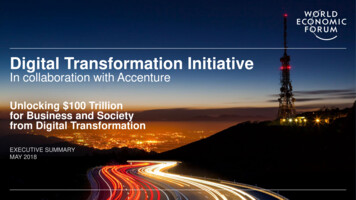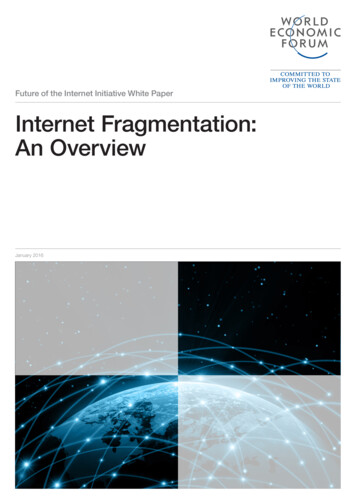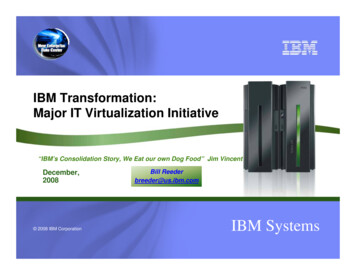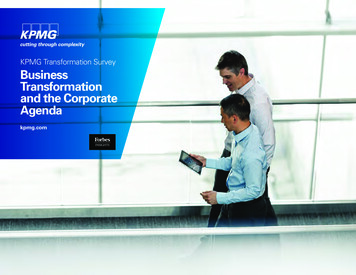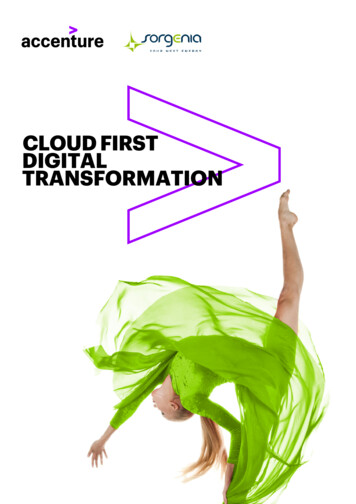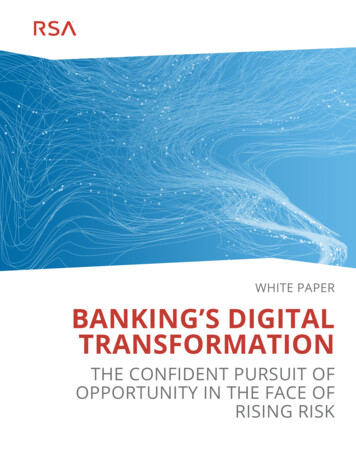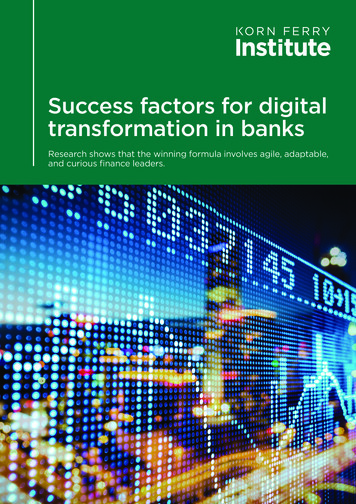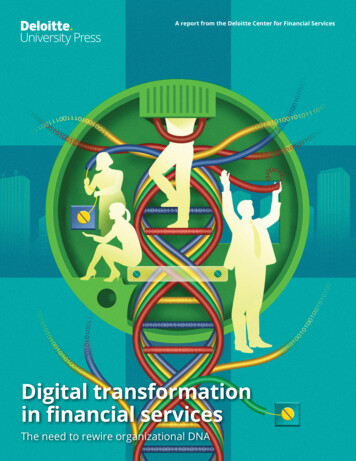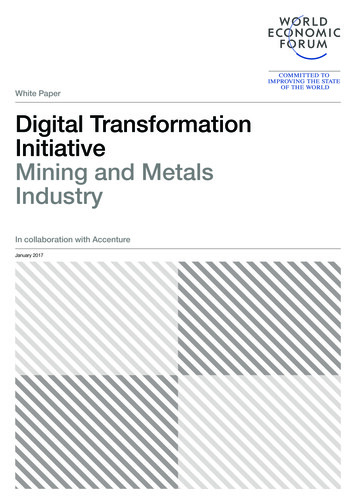
Transcription
White PaperDigital TransformationInitiativeMining and MetalsIndustryIn collaboration with AccentureJanuary 2017
World Economic Forum91-93 route de la CapiteCH-1223 Cologny/GenevaSwitzerlandTel.: 41 (0)22 869 1212Fax: 41 (0)22 786 2744Email: contact@weforum.orgwww.weforum.orgWorld Economic Forum 2017 – All rights reserved.No part of this publication may be reproduced orTransmitted in any form or by any means, includingPhotocopying and recording, or by any informationStorage and retrieval system.The views expressed in this White Paper are thoseof the author(s) and do not necessarily represent theviews of the World Economic Forum or its Membersand Partners. White Papers are submitted to the WorldEconomic Forum as contributions to its insight areasand interactions, and the Forum makes the final decisionon the publication of the White Paper. White Papersdescribe research in progress by the author(s) and arepublished to elicit comments and further debate.REF 060117The Digital Transformation InitiativeThe Digital Transformation Initiative (DTI) is a project launched by the WorldEconomic Forum in 2015 as part of the System Initiative on Shaping the Futureof Digital Economy and Society. It is an ongoing initiative that serves as thefocal point at the Forum for new opportunities and themes arising from latestdevelopments in the digitalization of business and society. It supports theForum’s broader activity around the theme of the Fourth Industrial Revolution.To find out more about the DTI project, tion
ContentsForeword3Foreword4Executive SummaryDigital transformation is emerging as a driver of sweeping change in the world around us.Connectivity has the potential to empower millions of people, while providing businesseswith unparalleled opportunities for value creation and capture.6Industry Situation and the Impact ofDigital Disruption6Industry situation8Emergence of digital disruption9The industry's technologicalresponse to date10 Detailed Themes and Initiatives11 Automation, robots andoperational hardware15 Digitally enabled workforce18 Integrated enterprise, platformand ecosystem20 Next-generation analytics anddecision support23 Value-at-Stake Analysis23 Methodology24 Value-at-stake findings26 Pivoting to a Digital Future26 Industry challenges revisited27 Digital adoption considerations29 Digital transformation andindustry restructuring30 Recommendations for SuccessfulDigital Transformation30 Recommendations for industry31 Recommendationsforcommunities, policy-makersand governments32 Appendix33 Acknowledgements34 Contributors35 EndnotesWithin the mining and metals industry, digitalization will be a force that changes thenature of companies and their interaction with employees, communities, government andthe environment at every step of the value chain. From mineral exploration and valuation,through mining, ore processing and metals production, to downstream sales anddistribution, digitalization is blurring traditional industry lines and challenging thebusiness models of the past.For companies that embrace digitalization, it offers the promise of a more nimble andprofitable business, with improved decision-making and increased employeeempowerment. More importantly, when designed and implemented correctly,digitalization can improve health, safety and environmental impact – saving lives,reducing injuries, lowering emissions and waste, and increasing transparencyand sustainability.It is clear that digitalization will be a source of transformational change, but there are anumber of challenges that need to be overcome. In many cases, the gains fromdigitalization have been inequitable, with the benefits not reaching those who need themmost. As technology empowers some workers and creates new jobs, it could alsothreaten traditional roles. An exponential increase in global information flows has alsogenerated new risks around data privacy and security. Meanwhile, businesses acrosssectors are grappling with challenges related to changing customer expectations,cultural transformation, outdated regulation and skill shortages, among others.The World Economic Forum is committed to helping leaders understand the implicationsof digitalization and supporting them on the journey to shape better opportunities forbusiness and society. The Digital Transformation Initiative (DTI) is a project launched bythe World Economic Forum in 2015 to serve as the focal point for new opportunities andthemes arising from the latest developments in the digitalization of business and society.It supports the Forum’s broader activity around the theme of the Fourth IndustrialRevolution.In 2015, the DTI project analysed the impact of digital transformation on six key industries– automotive, consumer goods, electricity, healthcare, logistics and media, and on threecross-industry topics – digital consumption, digital enterprise and societal implications.In 2016, the initiative was extended to cover seven additional industries, including miningand metals, and two new cross-industry themes: platform economy, and societal valueand policy imperatives. Through its broad focus, DTI has driven engagement on some ofthe most pressing topics facing industries and businesses today, and provided businessand policy leaders with an informed perspective on how to take action.The report was prepared in collaboration with Accenture, whom we would like to thankfor their support. We also extend our gratitude to the members of the World EconomicForum’s Mining and Metals DTI Advisory Group and the more than 40 experts fromindustry partners, government and academia who were involved in shaping the insightsand recommendations of this project.We are confident that the findings will contribute to improving the state of the worldthrough digital transformation, both for business and society.T.V. NarendranManaging Director, India, and SouthEast Asia, Tata SteelCo-chair of the World EconomicForum's Mining and Metals IndustryBruce WeineltHead of Digital TransformationWorld Economic ForumDigital Transformation Initiative: Mining and Metals3
Executive SummaryDigitally enabled workforce.Using connected mobility, and virtual andaugmented reality to empower field, remote andcentralized workers in real time. Keyinitiatives in scope are connected workers andremote operating centres.Harnessing technology is central tomaking mining safer and more efficient– from proprietary technologies thathelp us locate deposits, to autonomousequipment and fatigue monitoringsystems that protect our people, to socialmedia that keeps us in close contact withour stakeholders. The key is to select theright technology and to make the bestuse of available data.Integrated enterprise, platforms andecosystems.Linking operations, IT layers and devices orsystems that are currently separate. Keyinitiatives in scope are information technology (IT)and operational technology (OT) integration,asset cybersecurity and integrated sourcing,data exchange and commerce.Next-generation analytics and decisionsupport.Leveraging algorithms and artificial intelligenceto process data from sources within and beyondthe traditional value chain to provide real-timedecision support and future projections. Keyinitiatives in scope are advanced analytics,simulation modelling and artificial intelligence.Gary Goldberg, President and Chief Executive Officer, Newmont MiningCorporation, USAFive years after this century’s commodity boom peaked in2011, the global mining and metals industry is still adjustingto a set of strong headwinds. These include: anaemic globaldemand growth, as China’s economy shifts away fromresource-intensive manufacturing; massive excess capacity,weak pricing and increasing volatility; workforce skill gaps;increasing pressure from customer requirements; growingresource nationalism and regulation; declining resourceaccess and quality; and mounting trade friction along allsteps in the value chain.There is no evidence to suggest that these trends will reverseany time soon. On the contrary, they are likely to persistindefinitely, defining the industry's “new normal”. Moreover,across industries, the current value-chain structure withincumbent businesses is being challenged not only bymacroeconomic conditions, but by increasingly fast-movingand pervasive digitalization.Putting a value on digital transformationOur value-at-stake analysis is a quantitative model that aimsto assess the cumulative value impact over the next 10 yearsof digital transformation initiatives on the mining and metalsindustry, its customers, society and the environment (SeeSection 5). Key findings from this analysis show thatdigitalization could generate:––Digital themesDigital technologies have tremendous potential to movebeyond stagnant growth and deliver exceptional shareholder,customer and environmental value. In particular, there arefour themes that are expected to be central to thedigitalization of the industry over the next decade:Automation, robotics and operationalhardware.Deploying digitally enabled hardware tools toperform or improve activities that havetraditionally been carried out manually or withhuman-controlled machinery. Key initiatives inscope are sensors, robots and 3D printing.4Digital Transformation Initiative: Mining and Metals––More than 425 billion of value for the industry,customers, society and environment over the next 10years (to 2025). This is the equivalent of 3-4% ofindustry revenue during the same period.More than 320 billion of industry value over the nextdecade, with a potential benefit of approximately 190billion for the mining sector and 130 billion for themetals sector. The total for mining and metals isequivalent to 2.7% of industry revenue and 9% ofindustry profit.A reduction of 610 million tonnes of CO2 emissions,with an estimated value to society and environment of 30 billion.An improvement in safety, with around 1,000 livessaved and 44,000 injuries avoided. This equatesapproximately to a 10% decrease in lives lost and a20% decrease in injuries in the industry.However, the potential loss of about 330,000 jobs, or nearly5% of workforce, over the next decade as a consequence ofincreased digitalization must also be considered and, wherepossible, mitigated.
ImplicationsAdvances in digital technology could transform mining andmetals as an industry and at the enterprise level. Though thedigital technologies and capabilities discussed are in varyingstages of maturity and usefulness, one can already see a vastdifference across mining and metals companies in terms oftesting, adoption and expected benefits. For thoseorganizations that can move from being digital laggards todigital first movers, the value is real; a pro-forma projection ofvalue at stake at enterprise level for an average mining andmetals company showed a substantial increase in 2025EBITDA of a digital first mover versus a digital laggard.1Companies – in collaboration with the larger community –must take steps to enhance their digital capabilities, helpingthem to improve their bottom line, become more responsiveand resilient to industry challenges, and develop into moresustainable, transparent organizations.––Prioritize KPIs and aggregate data: Though there area number of possible key performance indicators (KPIs)that have been used to tie mining and metals to localdevelopment, there is no clear standard or repositorythat can give a full causal view or suggest how to bestinvest for industry and society.Improve transparency and traceability: Actively usedigital platforms to trace and share information aboutsourcing, production, and environmental and communityengagement.Recommendations for a successful digital transformationSuccessful digitalization will require collaboration betweenindustry leaders, communities and policy-makers. Thefollowing are a set of considerations developed for bothindustry and other stakeholders.For Industry Leaders– Align strategy and operations towards innovation:Build a focused strategy that incorporates digital, andaligns it with their business model, processes andorganization, to encourage digital usage andexperimentation.– Look outside your current business: Players thateffectively connect outside their current portion of thevalue chain can extract further value, whether it beconnecting or engaging in new areas with buyers,suppliers, customers or value added activities andproducts.– Improve data access and relevance: Focus on gettingreal, applicable insights from data and sharing them clearlyand effectively with the right levels of the organization.– Engage and train tomorrow's digital workforce:Technology and innovation often fail not through lack ofinvestment or weakness of the technology, but through alack of cultural change. The digital worker of tomorrowmust be engaged and prepared today.– Invest in alternative benefits, not just jobs: Invest nowin finding other ways to work with and compensate localstakeholders for the responsible use of their resources.– Forge new partnerships and strengthen existing ones:Improving active and open partnerships is the foundationfor best-in-class digitalization, stronger integration withlocal stakeholders, and even new models of operation andownership of mining and metals fixed assets.For communities, policy-makers and governments– Define effective digital standardization and regulation:Define a set of data ownership and format standards thatwill encourage interoperability and the sharing ofinformation across pieces of the digital ecosystem, whilemaintaining the levels of privacy and security that areneeded.Digital Transformation Initiative: Mining and Metals5
Industry Situation and the Impact ofDigital DisruptionA challenging outlook looks set to become the “new normal”. To thrive in this environment, mining andmetals companies must seize the opportunities offered by digital technologies.This white paper explores how digital technologies aret
White Papers are submitted to the World Economic Forum as contributions to its insight areas and interactions, and the Forum makes the final decision on the publication of the White Paper. White Papers describe research in progress by the author(s) and are published to elicit comments and further debate. REF 060117 The Digital Transformation Initiative The Digital Transformation Initiative .
